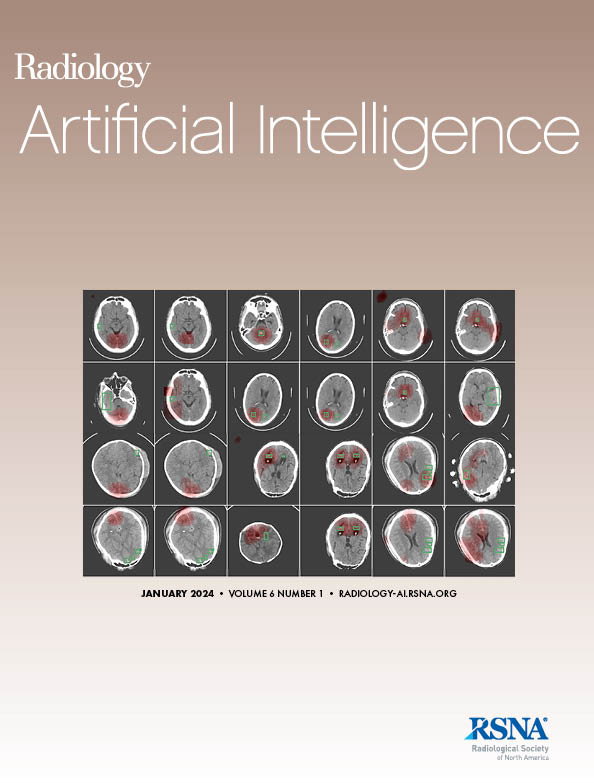下载PDF
{"title":"Image Quality and Diagnostic Performance of Low-Dose Liver CT with Deep Learning Reconstruction versus Standard-Dose CT.","authors":"Dong Ho Lee, Jeong Min Lee, Chang Hee Lee, Saif Afat, Ahmed Othman","doi":"10.1148/ryai.230192","DOIUrl":null,"url":null,"abstract":"<p><p>Purpose To compare the image quality and diagnostic capability in detecting malignant liver tumors of low-dose CT (LDCT, 33% dose) with deep learning-based denoising (DLD) and standard-dose CT (SDCT, 100% dose) with model-based iterative reconstruction (MBIR). Materials and Methods In this prospective, multicenter, noninferiority study, individuals referred for liver CT scans were enrolled from three tertiary referral hospitals between February 2021 and August 2022. All liver CT scans were conducted using a dual-source scanner with the dose split into tubes A (67% dose) and B (33% dose). Blended images from tubes A and B were created using MBIR to produce SDCT images, whereas LDCT images used data from tube B and were reconstructed with DLD. The noise in liver images was measured and compared between imaging techniques. The diagnostic performance of each technique in detecting malignant liver tumors was evaluated by three independent radiologists using jackknife alternative free-response receiver operating characteristic analysis. Noninferiority of LDCT compared with SDCT was declared when the lower limit of the 95% CI for the difference in figure of merit (FOM) was greater than -0.10. Results A total of 296 participants (196 men, 100 women; mean age, 60.5 years ± 13.3 [SD]) were included. The mean noise level in the liver was significantly lower for LDCT (10.1) compared with SDCT (10.7) (<i>P</i> < .001). Diagnostic performance was assessed in 246 participants (108 malignant tumors in 90 participants). The reader-averaged FOM was 0.880 for SDCT and 0.875 for LDCT (<i>P</i> = .35). The difference fell within the noninferiority margin (difference, -0.005 [95% CI: -0.024, 0.012]). Conclusion Compared with SDCT with MBIR, LDCT using 33% of the standard radiation dose had reduced image noise and comparable diagnostic performance in detecting malignant liver tumors. <b>Keywords:</b> CT, Abdomen/GI, Liver, Comparative Studies, Diagnosis, Reconstruction Algorithms Clinical trial registration no. NCT05804799 © RSNA, 2024 <i>Supplemental material is available for this article.</i></p>","PeriodicalId":29787,"journal":{"name":"Radiology-Artificial Intelligence","volume":" ","pages":"e230192"},"PeriodicalIF":8.1000,"publicationDate":"2024-03-01","publicationTypes":"Journal Article","fieldsOfStudy":null,"isOpenAccess":false,"openAccessPdf":"https://www.ncbi.nlm.nih.gov/pmc/articles/PMC10982822/pdf/","citationCount":"0","resultStr":null,"platform":"Semanticscholar","paperid":null,"PeriodicalName":"Radiology-Artificial Intelligence","FirstCategoryId":"1085","ListUrlMain":"https://doi.org/10.1148/ryai.230192","RegionNum":0,"RegionCategory":null,"ArticlePicture":[],"TitleCN":null,"AbstractTextCN":null,"PMCID":null,"EPubDate":"","PubModel":"","JCR":"Q1","JCRName":"COMPUTER SCIENCE, ARTIFICIAL INTELLIGENCE","Score":null,"Total":0}
引用次数: 0
引用
批量引用
Abstract
Purpose To compare the image quality and diagnostic capability in detecting malignant liver tumors of low-dose CT (LDCT, 33% dose) with deep learning-based denoising (DLD) and standard-dose CT (SDCT, 100% dose) with model-based iterative reconstruction (MBIR). Materials and Methods In this prospective, multicenter, noninferiority study, individuals referred for liver CT scans were enrolled from three tertiary referral hospitals between February 2021 and August 2022. All liver CT scans were conducted using a dual-source scanner with the dose split into tubes A (67% dose) and B (33% dose). Blended images from tubes A and B were created using MBIR to produce SDCT images, whereas LDCT images used data from tube B and were reconstructed with DLD. The noise in liver images was measured and compared between imaging techniques. The diagnostic performance of each technique in detecting malignant liver tumors was evaluated by three independent radiologists using jackknife alternative free-response receiver operating characteristic analysis. Noninferiority of LDCT compared with SDCT was declared when the lower limit of the 95% CI for the difference in figure of merit (FOM) was greater than -0.10. Results A total of 296 participants (196 men, 100 women; mean age, 60.5 years ± 13.3 [SD]) were included. The mean noise level in the liver was significantly lower for LDCT (10.1) compared with SDCT (10.7) (P < .001). Diagnostic performance was assessed in 246 participants (108 malignant tumors in 90 participants). The reader-averaged FOM was 0.880 for SDCT and 0.875 for LDCT (P = .35). The difference fell within the noninferiority margin (difference, -0.005 [95% CI: -0.024, 0.012]). Conclusion Compared with SDCT with MBIR, LDCT using 33% of the standard radiation dose had reduced image noise and comparable diagnostic performance in detecting malignant liver tumors. Keywords: CT, Abdomen/GI, Liver, Comparative Studies, Diagnosis, Reconstruction Algorithms Clinical trial registration no. NCT05804799 © RSNA, 2024 Supplemental material is available for this article.
采用深度学习重建技术的低剂量肝脏 CT 与标准剂量 CT 的图像质量和诊断性能对比。
"刚刚接受 "的论文经过同行评审,已被接受在《放射学》上发表:人工智能》上发表。这篇文章在以最终版本发表之前,还将经过校对、排版和校对审核。请注意,在制作最终校对稿的过程中,可能会发现影响内容的错误。目的 比较基于深度学习去噪(DLD)的低剂量 CT(LDCT,33% 剂量)和基于模型迭代重建(MBIR)的标准剂量 CT(SDCT,100% 剂量)在检测恶性肝肿瘤方面的图像质量和诊断能力。材料与方法 在这项前瞻性、多中心、非劣效性研究(研究标识符:NCT05804799)中,三家三级转诊医院在 2021 年 2 月至 2022 年 8 月期间接收了转诊的肝脏 CT 扫描患者。所有肝脏 CT 扫描均使用双源扫描仪进行,剂量分为 A 管(67% 剂量)和 B 管(33% 剂量)。A 管和 B 管的混合图像使用 MBIR 生成 SDCT 图像,而 LDCT 图像使用 B 管的数据,并使用 DLD 进行重建。对肝脏的图像噪声进行了测量,并对不同成像技术进行了比较。由三位独立的放射科医生使用杰克刀替代自由反应接收器操作特征分析法评估了每种技术在检测恶性肝肿瘤方面的诊断性能。当优点系数(FOM)差异的 95% CI 下限大于-0.10 时,即宣布 LDCT 与 SDCT 相比无劣效性。结果 共纳入 296 名参与者(196 名男性,100 名女性;平均年龄为 60.5 ± [SD] 13.3 岁)。LDCT 的肝脏平均噪音水平(10.1)明显低于 SDCT(10.7)(P < .001)。对 246 名参与者(90 名参与者中有 108 个恶性肿瘤)的诊断性能进行了评估。SDCT的读者平均FOM为0.880,LDCT为0.875(P = .35)。差异在非劣性范围内(差异,-0.005;95% CI,-0.024 至 0.012)。结论 与使用 MBIR 的 SDCT 相比,使用 33% 标准辐射剂量的 LDCT 在检测恶性肝脏肿瘤方面具有更低的图像噪声和相当的诊断性能。©RSNA,2024。
本文章由计算机程序翻译,如有差异,请以英文原文为准。

 求助内容:
求助内容: 应助结果提醒方式:
应助结果提醒方式:


